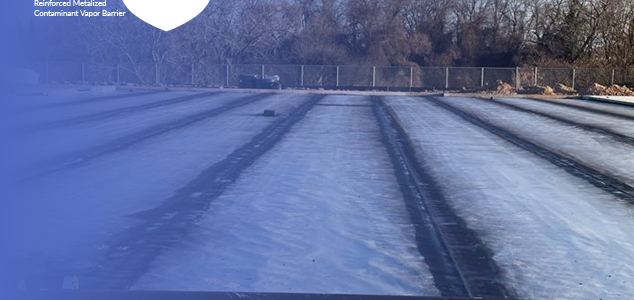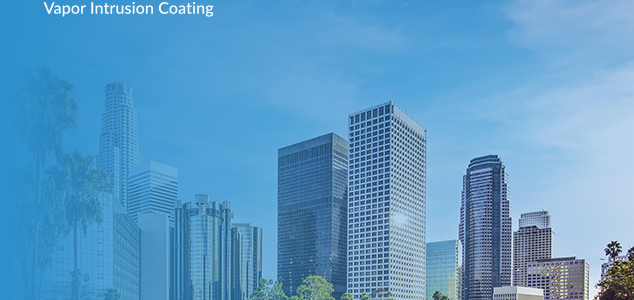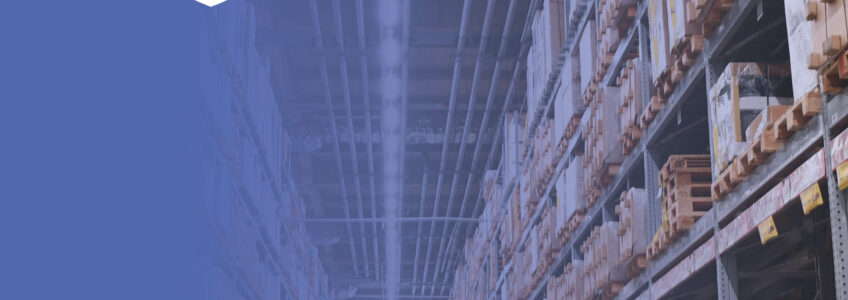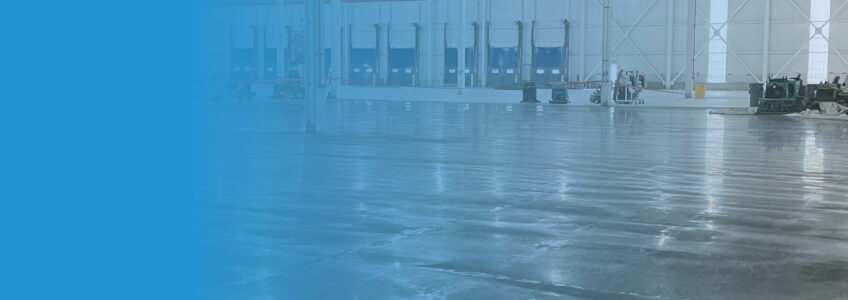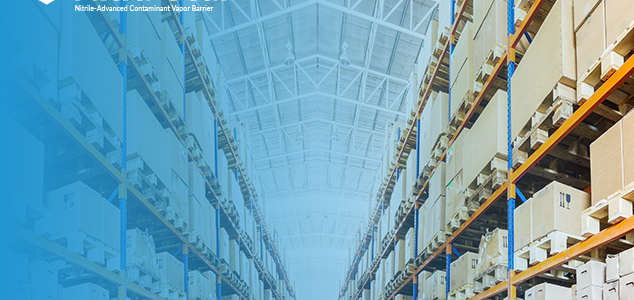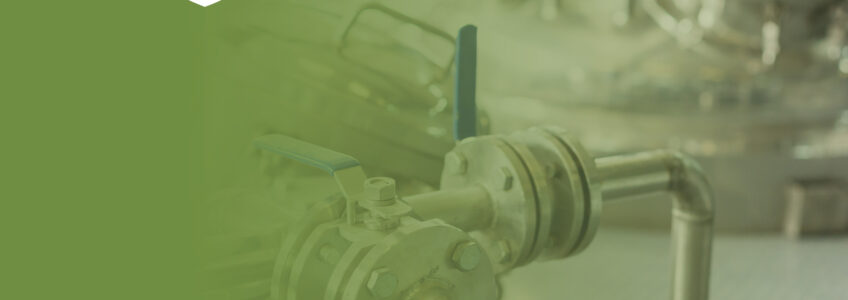MonoShield Protects Warehouse Against Potential Methane Vapor Intrusion
Project snapshot highlights:
- Easy, fast installation leads to successful implementation during winter conditions
- Effective implementation in near-freezing temperatures
- 220,000 square feet of MonoShield installed
A 220,000-square-foot warehouse development in Maryland, located near a former landfill, required contaminant vapor mitigation measures against the potential for methane vapor intrusion (VI). The initial VI mitigation system design proposed a 20-mil plastic membrane with taped seams. While this design met the minimum requirements for VI protection, its implementation during winter posed significant challenges. Cold weather conditions can diminish the workability of taped-barrier systems, leading to significant in-field challenges and project delays. To circumvent these issues and ensure adequate protection against methane VI, the project team sought the expertise of Land Science® for its MonoShield® Reinforced Metalized Contaminant Vapor Barrier and TerraVent Low-Profile Venting System.
1.2 Million Square Foot MonoShield Barrier Protects Future Tenants at Historic Manufacturing Site
Case study highlights:
- 1.2 million square feet of MonoShield installed in new logistics center
- MonoShield provides advanced chemical protection with a rapid installation process
- Land Science Certified Applicator, MTN, Inc. leverages experience to ensure the investment is protected
On the site of one of the largest former steel mills in the world, a large logistics center redevelopment project is underway. Strategically positioned along the I-95 Corridor, the ongoing development promises to transform the historic site eventually into 15 million square feet of warehousing space. With plans for 20 buildings, the developer is investing $1.6 billion in both the construction and remediation of the once blighted site. The former steel mill site had been impacted by chlorinated solvents and petroleum contaminants in different areas of the property. Therefore, a component of the remediation and redevelopment efforts involves addressing the potential for vapor intrusion (VI). A design engineer was brought onto the team to develop a VI mitigation plan to ensure a safe and healthy environment for future building workers.
Retro-Coat Protects Los Angeles Contemporary Art Gallery
Case study highlights:
- Retro-Coat Vapor Intrusion Coating System application achieved compliance with the Los Angeles Regional Water Quality Control Board (LARWQCB) standards for VI mitigation
- Retro-Coat chosen as a low-cost mitigation solution with outstanding chemical resistance that provides aesthetic value to a building’s interior space
- Land Science Certified Applicator, Systems Waterproofing ensured the manufacturer’s specifications were strictly followed
This case study reviews a site where PCE (perchloroethene) was detected in the soil gas beneath a commercial building housing a contemporary art gallery and studio suite in a Los Angeles neighborhood. A Vapor Intrusion Mitigation Plan using Retro-Coat from Land Science was quickly reviewed and approved by LARWQCB.
TerraShield Installation Leads to Development of Animal Welfare Facility
Case study highlights:
- Terra-Shield chosen due to its high chemical resistance
- Successful contaminant vapor intrusion mitigation allows for new state-of-the-art animal center to open to the public
- Installation was seamless due to the use of NitraCore, TerraShield’s spray-applied nitrile-modified asphalt
A local animal welfare organization needed a new building and outdoor space to provide a state-of-the-art center for animal care in an urban community. United Consulting, a multi-disciplinary engineering and environmental consulting firm based in Georgia, was engaged to develop a plan for remediating the soil impacts and assessing vapor intrusion risk at a prospective site. Methane was identified in the vapor phase, requiring mitigation to reduce the vapor intrusion risk. United Consulting specified TerraShield due to its high level of protection against contaminant vapor intrusion. With the building protected from vapor intrusion by TerraShield, the facility workers, prospective pet foster parents, and the animals are ensured a safe breathing environment.
Logistics Center Selects MonoShield to Protect Occupants Long-Term
Case study highlights:
- Developer saves time and money, selecting an easier to install vapor mitigation solution offering more protection long-term
- MonoShield provides unmatched durability, ease of installation, and superior chemical resistance compared to thin-mil plastic barriers
- Selecting Edgeboro to install MonoShield is a bottom-line cost-savings and investment-protection decision
Scheduling delays and continuous repairs to a 20-mil plastic vapor barrier at a major new logistics complex in New Jersey prompted the project team to change course, engaging Edgeboro, one of the region’s most experienced vapor barrier installation specialists. Edgeboro introduced the development team to Land Science and Monoshield. The MonoShield contaminant vapor barrier system offered the promise of performance and was proven to stand up to heavy construction activities. In addition, the installation speed and the key benefits provided by MonoShield led the developer to select Edgeboro and MonoShield for the rest of the buildings planned.
Nitra-Seal Ensures Healthy Work Environment at New Electric Vehicle Plant
Project snapshot highlights:
- Major automaker trusts Land Science to proactively address potential vapor intrusion risk
- Nitra-Seal selected because it offered the best economic value for the level of vapor intrusion protection provided
- The new technologically advanced facility creates hundreds of new jobs for Southeast Michigan residents
A leading automobile manufacturer built a new 520,000-square-foot electric vehicle facility on the site of one of its former plants in Detroit, Michigan. The former site had a long history of automotive manufacturing. Considering the site’s history, and the potential for lingering solvent, fuel, or other subsurface chemical impacts, the auto company was proactive in applying a proven and effective contaminant vapor intrusion solution to ensure a healthy working environment for its employees. Ultimately, Nitra Seal® Nitrile-Advanced Contaminant Vapor Barrier with TerraVent™ Low Profile Venting System, was selected by the construction project team, offering the best economic value for the level of VI protection provided. MTN, Inc., a Land Science Certified Applicator, completed the installation with high efficiency, working directly with the concrete subcontractor to meet the scheduled production rate of the Nitra-Seal system installation. Quality assurance and control testing were completed per manufacturer’s specifications, verifying the integrity and proper installation of the contaminant vapor barrier system.
Nitra-Seal Protects Multi-Acre Tampa Logistics Center
Project snapshot highlights:
- 245,000 square foot installation eliminates vapor intrusion threat to future tenants
- Land Science’s technical expertise and support in assisting with the VIMS design were critical factors in the selection process
- High level of vapor intrusion protection ensured for future logistics center workers and office staff
A new, expansive logistics center in Tampa, Florida, was the site of a former brownfield, where past operations left petroleum hydrocarbons and methane contaminants in soil and groundwater. The project required a cost effective solution to mitigate the potential vapor intrusion risk from these contaminants. After reviewing multiple vapor intrusion mitigation system (VIMS) options, the project team ultimately selected the Nitra-Seal® NitrileAdvanced Contaminant Vapor Barrier and TerraVent™ Low Profile Venting System. Nitra-Seal was viewed as the best available, most cost-efficient technology for the large logistics center considering the site conditions and level of contaminant risk. With a foundation approaching a quarter million square feet, and a tight project schedule, Nitra-Seal’s nitrile-modified sprayapplied core results in faster installations, while also providing superior chemical protection, separating it from other VI systems considered. Land Science’s technical expertise and support in assisting with the VIMS design were also critical factors in the selection process.
Nitra-Seal Installed at Large Chicago E-Commerce Distribution Center
Project snapshot highlights:
- Seamless coordination kept the 4.4-acre installation ahead of schedule for the fast-moving project
- 190,000 Square Feet of Nitra-Seal Installed
- New e-commerce distribution center met the IEPA’s TACO guidelines for mitigating the VI exposure pathway and the tenant’s requirements for a healthy built environment
With little to no green sites to develop in the Chicagoland area, many new building projects occur in former industrial areas that have been environmentally impacted. Such was the case for a new 190,000 squarefoot e-commerce distribution center constructed with a Nitra-Seal® Nitrile-Advanced Contaminant Vapor Barrier and TerraVent™ Low Profile Venting System to address the potential for vapor intrusion (VI). The advanced vapor barrier system met the Illinois Environmental Protection Agency’s (IEPA’s) Tiered Approach to Corrective Action Objectives (i.e., TACO) for remediating the VI exposure pathway.
VOC Risk Mitigated at Site of Former Chemical Manufacturer
Project snapshot highlights:
- TerraShield chosen as most protective, economical vapor intrusion mitigation solution for large logistics facility
- Future occupants protected against volatile organic compounds
- TerraShield successfully installed on time and within budget
A long-vacant San Francisco Bay Area brownfield was once the site of a former chemical plant that produced chlorofluorocarbons, fuel additive anti-knock compounds, and titanium dioxide from 1956 to 1997. With onsite rail service and more than three million households within 50 miles, the property was considered a prime location for a new 2.2 million square foot logistics development. However, the site’s prior industrial history left residual volatile organic compounds (VOCs) in the subsurface and posed a potential vapor intrusion risk. Following a cost-benefit analysis and thorough evaluation of contaminant vapor barrier systems available, TerraShield® Metalized Nitrile Contaminant Vapor Barrier was selected for the new logistics building.
MonoShield Protects Large Texas Warehouse Site Against Vapor Intrusion
Case study highlights:
- Rapid installation keeps fast-moving Brownfield redevelopment project on track
- MonoShield selected as best alternative for chemical resistance, competitive cost, and installation speed
- Project meets aggressive time and budget constraints, ensuring safe breathing environment
The project is led by Reserve Capital Partners, a leading commercial real estate development company. Its construction arm, Reserve Construction, is transforming the former brownfield into valuable warehouse space. As a leader in the field, Reserve Capital Partners has invested millions of dollars in developing and managing high-value properties for clients and investors throughout the Dallas area. The Marquis Development consists of two expansive logistical warehouse buildings covering approximately 200,000 square feet. Due to past industrial activities in the surrounding area, a vapor intrusion mitigation system (VIMS) was required for newly constructed buildings on the property.


